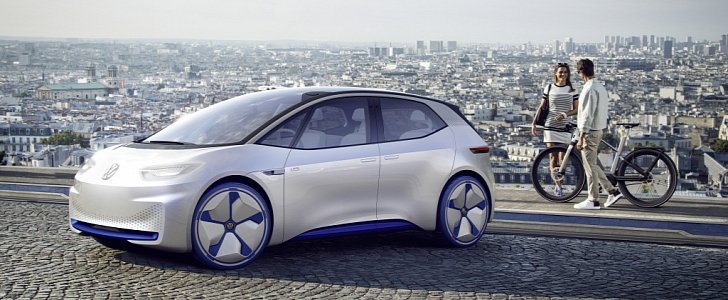Presented at the 2016 Paris Motor Show, the Volkswagen I.D. is going into production in November 2019 at the Zwickau plant in Germany. The first EV built on the MEB vehicle architecture serves as a turning point for Volkswagen, which is still feeling the repercussions of the Dieselgate scandal from three years ago.
Like EQ from Mercedes-Benz, I.D. serves as a sub-brand for Volkswagen. Based on a trademark filed with the European Union Intellectual Property Office earlier this year, the Germans are expected to name the I.D. hatchback Neo. Love it or hate it, we’re expecting a lot of Matrix fans to be triggered if this turns out to be the case indeed.
Auto Express explains that “nothing at this stage has been confirmed,” including the production nameplates for the I.D. Buzz and I.D Vizzion concepts. On the other hand, the publication suggests “I.D. Neo could be just a development codename for the vehicle.”
Teased to a lesser extent at the unveiling of the modular electric drive matrix, the I.D. is the first step in creating “massive economies of scale” according to Thomas Ulbrich. The man in charge of e-mobility at Volkswagen says that the MEB is suitable for large batteries as well, fast-charging capability, and autonomous driving technologies.
As many as 27 models based on the Modularer Elektrifizierungsbaukasten will be on the roads by 2022, with Volkswagen hoping to sell as many electric vehicles as possible by the half of the next decade. The target is to manufacture one million MEB-based vehicles per year, though it remains to be seen if Volkswagen can pull it off.
The batteries for the I.D. Neo will be produced in Braunschweig, whereas the rotors and stators will be manufactured in Salzgitter. The platform, meanwhile, will be put together at the state-of-the-art facility in Kassel. Turning our attention back to the concept, the car in the photo gallery has an output of 170 PS. Acceleration to 100 km/h takes eight seconds, and top speed is quoted at 160 km/h.
A range of between 400 and 600 kilometers is how the cookie crumbles, depending on the capacity of the battery. Auto Express heard through the grapevine that three versions are in the offing, starting with an entry-level battery with 205 miles (330 kilometers) of range.
That would be a red flag for Volkswagen's part, but then again, the numbers announced for the concept are NEDC while Auto Express refers to WLTP.
Auto Express explains that “nothing at this stage has been confirmed,” including the production nameplates for the I.D. Buzz and I.D Vizzion concepts. On the other hand, the publication suggests “I.D. Neo could be just a development codename for the vehicle.”
Teased to a lesser extent at the unveiling of the modular electric drive matrix, the I.D. is the first step in creating “massive economies of scale” according to Thomas Ulbrich. The man in charge of e-mobility at Volkswagen says that the MEB is suitable for large batteries as well, fast-charging capability, and autonomous driving technologies.
As many as 27 models based on the Modularer Elektrifizierungsbaukasten will be on the roads by 2022, with Volkswagen hoping to sell as many electric vehicles as possible by the half of the next decade. The target is to manufacture one million MEB-based vehicles per year, though it remains to be seen if Volkswagen can pull it off.
The batteries for the I.D. Neo will be produced in Braunschweig, whereas the rotors and stators will be manufactured in Salzgitter. The platform, meanwhile, will be put together at the state-of-the-art facility in Kassel. Turning our attention back to the concept, the car in the photo gallery has an output of 170 PS. Acceleration to 100 km/h takes eight seconds, and top speed is quoted at 160 km/h.
A range of between 400 and 600 kilometers is how the cookie crumbles, depending on the capacity of the battery. Auto Express heard through the grapevine that three versions are in the offing, starting with an entry-level battery with 205 miles (330 kilometers) of range.
That would be a red flag for Volkswagen's part, but then again, the numbers announced for the concept are NEDC while Auto Express refers to WLTP.





















